Architecture, Spain
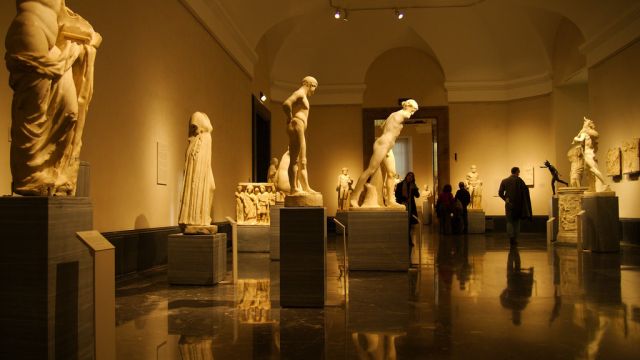
Removed from Unnamed collection
Prado Museum 
This gallery in Madrid has the most complete collection of Spanish painting from 11th-18th centuries, and numerous masterpieces by great universal artists such as El Greco, Velázquez, Goya, Bosch, Titian, Van Dyck and Rembrandt.
The quality and variety of its collection makes the Prado one of the world's best-endowed museums. It combines a first-class collection of Spanish painting, the most important works of the Flemish and Italian schools, and various fine examples of the German, French and English schools. It is home to numerous masterpieces of universal art such as Las Meninas by Velázquez, the two Majas by Goya, Nobleman with his hand on his chest by El Greco, the Garden of Delights by Bosch, and The Three Graces by Rubens, among other priceless pieces. Although the museum was created to house primarily works of painting and sculpture, it also contains major collections of drawings, engravings, coins and medals, as well as items of clothing and decorative art. http://www.spain.info/en/que-quieres/arte/museos/madrid/museo_nacional_del_prado.html
Map
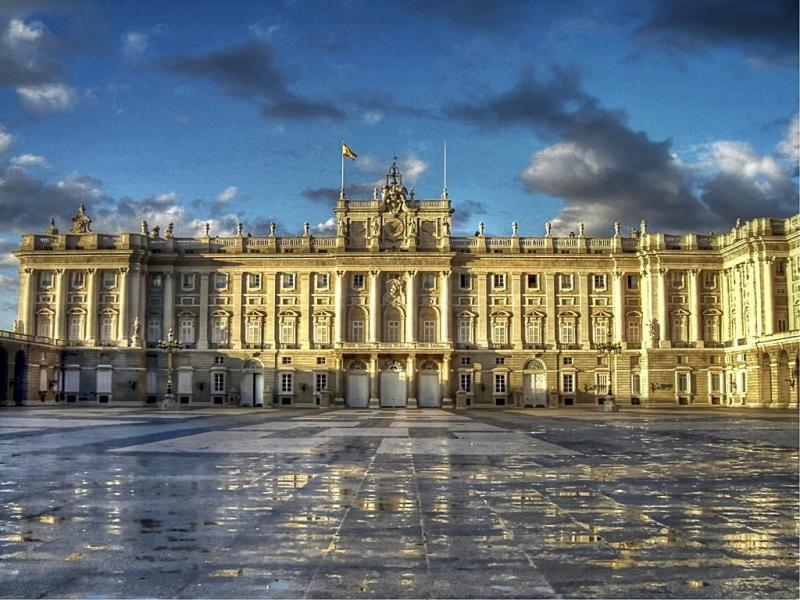
Removed from Unnamed collection
Royal Palace of Madrid 
Madrid's Royal Palace was built in the 18th century by order of Philip V on the site of the old Alcázar fortress, a former Moorish castle. Sachetti began the works in 1738, and the building was completed in 1764. Sabatini designed the southeast wing and the great staircase, or staircase of honour. It has a square floor plan with a large central courtyard. The Puerta del Príncipe gateway on the east side gives access to the central courtyard. The Sabatini and Campo del Moro Gardens are among the Palace's other attractions, as well as its several different façades. There is some debate as to its artistic style; it is thought by some experts to belong more to the Baroque, and by others to the Neo-classical style. Of particular note among its numerous rooms are the Royal Guards' Room, the Columns Room, the Hall of Mirrors and King Charles III's room. It also contains paintings by Velázquez, Goya, Rubens, El Greco and Caravaggio. http://www.spain.info/en/que-quieres/arte/monumentos/madrid/palacio_real.html
Map
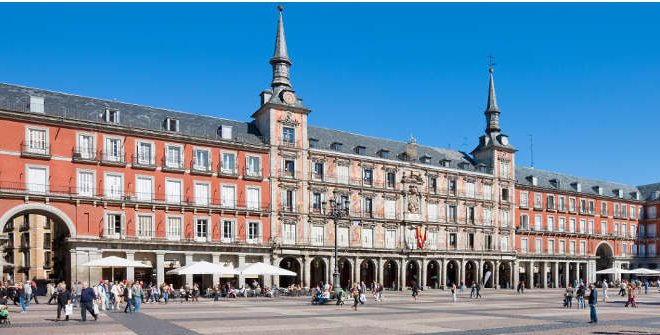
Removed from Unnamed collection
Plaza Mayor 
This portico lined square is situated at the heart of Hapsburg Madrid, the old part of the city and one of the capital’s most charming districts.
Before Madrid became a capital city, with its wide avenues and boulevards, its footprint consisted of narrow streets, alleys and passageways, which today take us back to the times of swashbuckling swordsmen and medieval rogues.
The foundations of Plaza Mayor were laid, when Philip II's court moved to Madrid, on the site of the former Plaza del Arrabal, where the town's most popular market was located towards the end of the 15th century. In 1617, architect Juan Gómez de Mora was commissioned to create a greater uniformity amongst the buildings in this location, which for centuries had hosted popular entertainments, bullfights, beatifications, coronations and the occasional auto de fe. https://www.esmadrid.com/en/tourist-information/plaza-mayor-madrid
Map

Removed from Unnamed collection
Puerta De Alcala Gate 
This is one of the most well-known monuments in Madrid. Built between 1769 and 1778 under the orders of King Carlos III, it was designed by Francisco Sabatini and erected as a triumphal arch to celebrate the arrival of the monarch at the capital. The granite gate is 19.5 metres tall and is elegant and well-proportioned. The façade features a number of decorative elements with groups of sculptures, capitals, reliefs and masks, among others. http://www.spain.info/en/que-quieres/arte/monumentos/madrid/puerta_de_alcala.html
Map
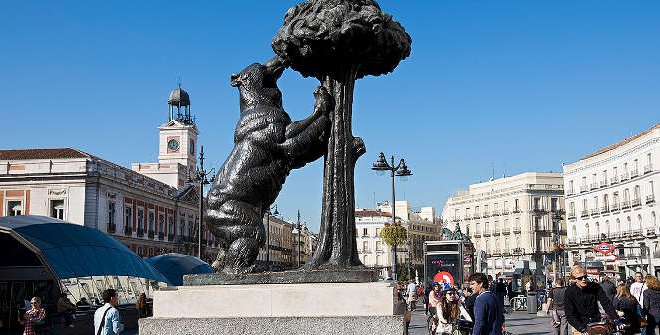
Removed from Unnamed collection
Puerta del Sol 
This bustling square located bang in the centre of Madrid is one of the city’s most famous sites. With its semi-circular shape, it is a junction for many of the city’s historical and busiest streets such as Mayor, Arenal, Alcalá and Preciados, as well as the starting point for all major radial roads in Spain.
Originally the site of one of the city’s gates, Puerta del Sol should be at the top of your list of places to visit. Sitting atop the Casa de Correos building, the current headquarters of the Madrid regional government, you’ll find the famous clock that all eyes turn to on the last day of the year. For over a century now tradition has it that people across the country usher in the New Year by eating 12 lucky grapes to the twelve chimes of midnight struck by this clock.
A stone slab on the pavement in front of the main entrance to the Casa de Correos marks Spain’s Kilometre 0, the starting point for all major radial roads in Spain. Across the square, at the beginning of Calle Alcalá, Madrid’s longest street, you’ll find the famous Oso y Madroño. The official symbol of the city, the statue of a bear nuzzling a strawberry tree is a popular meeting spot for Madrileños. https://www.esmadrid.com/en/tourist-information/puerta-del-sol
Map
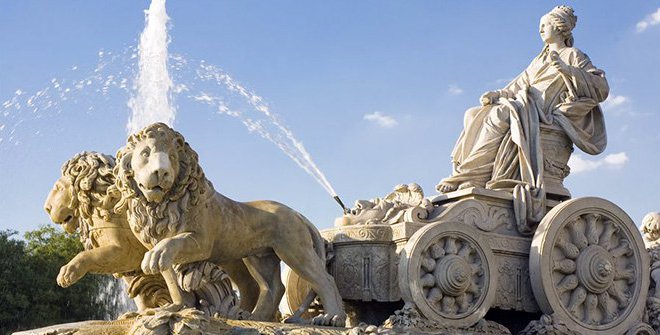
Removed from Unnamed collection
Cibeles Fountain 
Built in 1782, the Cibeles Fountain has been standing in this emblematic square since 1895. One of the city’s most famous landmarks, it depicts Cybele, the Great Mother and Roman goddess of fertility, atop a chariot drawn by two lions.
It stands in the centre of the Plaza de Cibeles, the square to which it has lent its name and which marks the start of Madrid’s avenue of art, the Paseo del Arte. The fountain is flanked by four magnificent buildings: Buenavista Palace (the Army’s General Headquarters), Linares Palace (which accommodates the Casa de América cultural institution), Cibeles Palace (previously the main Post Office, it now houses Madrid City Hall and CentroCentro cultural centre), and the Bank of Spain. Commissioned by King Charles III it was designed by renowned Spanish architect Ventura Rodriguez. All three figures were made with purple marble from the town of Montesclaros, in Toledo, and the rest of the monument was carved from stone from Redueña, an area 53km to the north of Madrid, close to the La Cabrera mountain range. https://www.esmadrid.com/en/tourist-information/fuente-de-la-cibeles
Map
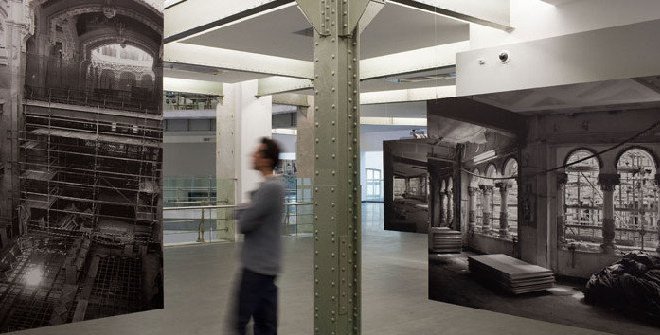
Removed from Unnamed collection
Plaza de Cibeles 
The stunning Palacio de Cibeles is not only the headquarters of Madrid City Council, it is also home to CentroCentro. A recent addition to the renowned Paseo del Arte, the cultural centre boasts a packed programme of activities that revolve around the city and includes exhibitions, workshops, conferences and concerts.
Next to the entrance hall, where you’ll find interactive information screens, there is a colourful lounge where visitors can sit back and read, connect to WiFi or enjoy some people-watching through the large windows that look out onto Plaza de Cibeles. The building has two restaurants: Colección Cibeles on the ground floor and Palacio de Cibeles on the 6th. Both are open Monday to Sunday. Also on the sixth floor is Terraza Cibeles, a great rooftop bar where you can relax with a pre-dinner drink or mid-afternoon snack as you take in the wonderful views of the Plaza de Cibeles and the Madrid skyline.
For even more breathtaking vistas, head up to the Mirador observation deck on the 8th floor. https://www.esmadrid.com/en/tourist-information/centrocentro-palacio-de-cibeles
Map
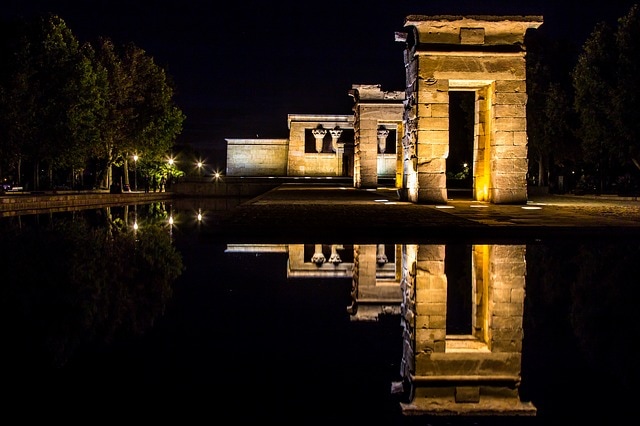
Removed from Unnamed collection
Temple of Debod Gardens 
In 1968, Manuel Herrero Palacios designed these 8 hectares of gardens so that one could sit and admire the magnificence of the Temple of Debod, which had been donated to Spain by the Government of Egypt. The Debod Mausoleum, which is more than 2,000 years old, was rescued from the waters of Aswan Dam by a group of Spanish archaeologists. They brought back every stone and rebuilt it in its present location, after the Government of Egypt donated it to Spain. It was set on the remains of Cuartel de la Montaña, retaining the orientation to the sun it had at its place of origin.
From here, the famous Manzanares cornice, with the Royal Palace, Casa de Campo and, possibly, the most beautiful sunsets in Madrid, can be seen. The garden’s parterres on both sides are merely a vegetation frame. They are enclosed with squares, banana trees for alignment and groups of palm trees and Mediterranean plants on the meadows. https://www.esmadrid.com/en/tourist-information/jardines-del-templo-de-debod
Map
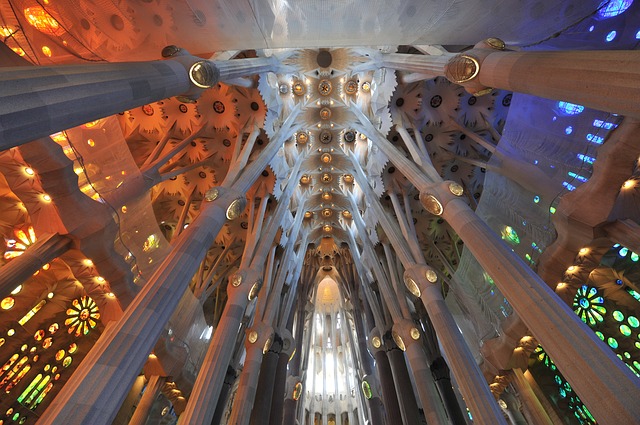
Removed from Unnamed collection
Sagrada Familia 
The Sagrada Familia is definitely the most famous building in Barcelona. Considered one of Gaudi’s masterpieces, it’s a key attraction in Barcelona and one of the most striking monuments ever built in the world.
In fact, there is absolutely no other building in the world featuring such a genius mixture between Gothic and Art Nouveau styles. Antoni Gaudí took over the project in 1883, a year after construction had begun, and completely reshaped the project to fit his unique style.
Unfortunately, Gaudí died in 1926 when only a quarter of the project had been constructed. Sadly, most of the blueprints left were burned in a fire, therefore, all that’s been built ever since has been a wide interpretation of Gaudi’s architecture.
Stopping over the Sagrada Familia should be top priority if you’re in Barcelona for the first time.
Visiting the basilica it’s an enjoyable experience and a great way to be introduced into Gaudí’s architecture. Besides, it offers the best possible views of the surrounding Eixample District, Barcelona’s own Big Apple. https://barcelonando.com/sagrada-familia
Map

Removed from Unnamed collection
Park Guell 
Park Guell is one of the most fantastic designs ever built by Gaudi. A landmark on its own, it features amazing views of Barcelona and plenty of modernist works. Needless to say, as soon you pass the entrance, you’ll notice right away that this isn’t an ordinary park.
Curiously, Park Güell wasn’t originally intended to be a park, but rather a project for luxurious homes. In 1900, the site was just a rocky hill with nothing but vegetation around, in the vicinity of some isolated upper class country houses. The result was one of the most fascinating works by Gaudí.
The intention of the project was to take advantage of the breathtaking views of Barcelona and the clean fresh air, away from the factories, in order to build a top of the line housing complex.
In Park Guell, there are plenty of paths and vegetation to enjoy, but the architectural structures are the glue that holds the whole place together. https://barcelonando.com/parc-guell
Map
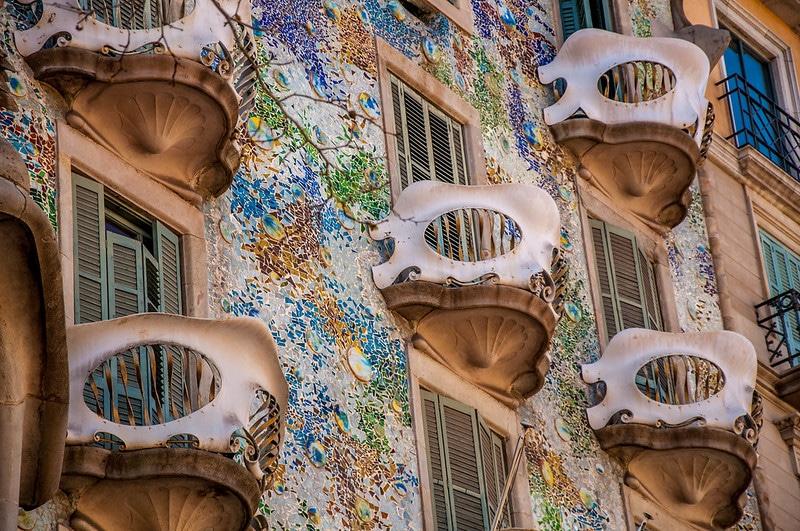
Removed from Unnamed collection
Casa Batllo 
Casa Batllo is one of Barcelona’s biggest landmarks. If buildings could be celebrities, there would be a perpetual red carpet in front of it. The remarkable facade it’s the most prominent feature and it has been subject to many interpretations.
Originally, Gaudí didn’t build Casa Batlló. He was hired to redesign the late 1800’s building in 1904, and the result was one of his most emblematic works in Barcelona along the Sagrada Familia. The building was transformed into one that hardly resembles the original. Animal and nature forms inspired the facade of Casa Batlló. For example, the skull shape of the balconies.
As beautiful as is the outside, you must schedule a visit to the interior to witness the most original and jaw-dropping architecture.
To begin with, a good part of the outside is covered with bits and pieces of broken and multicolored ceramic tiles, a technique called Trencadís, which was used massively by Gaudi in most of his works, visible for example in the Park Güell benches. An interesting effect is created when direct sunlight hits the building, as the tiles shift through different shades of colors along with the stained glass windows. https://barcelonando.com/casa-batllo
Map

Removed from Unnamed collection
Gothic Quarter 
The Gothic Quarter is one of the most famous landmarks in Barcelona. Located in the heart of the old city, this neighborhood features a fusion of buildings dating from Roman times to the 20th century.
The main attribute of the Gothic Quarter is the antique aspect of its buildings, narrow streets and the near absence of traffic. In fact, many areas are for pedestrians only and built like a labyrinth of winding streets and hidden squares. https://barcelonando.com/barri-gotic-gothic-quarter
Map
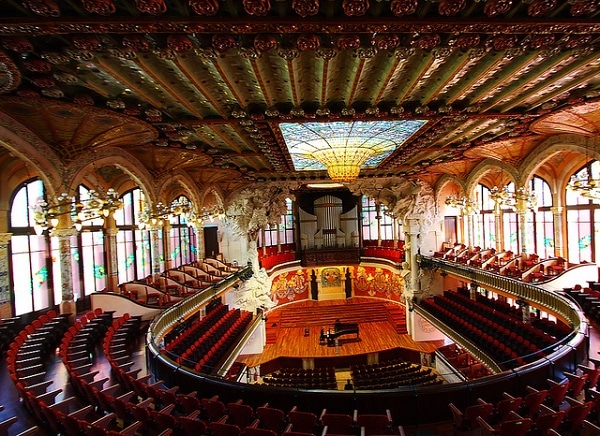
Removed from Unnamed collection
Palau de la Musica Catalana 
El Palau de la Musica Catalana is the most famous concert halls in Barcelona. Squeezed between the narrow streets of La Ribera neighborhood, is one of the most fantastic buildings of the Modernista movement. https://barcelonando.com/palau-de-la-musica-catalana
Map

Removed from Unnamed collection
Casa Amatller 
This amazing building, the Casa Amatller by Puig i Cadafalch, a contemporary of Gaudí, which combines the neo-Gothic style with a ridged façade inspired by houses in the Netherlands, is part of the block known as the "mansana de la discòrdia" of Barcelona. http://www.barcelonaturisme.com/wv3/en/page/1197/casa-amatller.html
Map

Removed from Unnamed collection
Parc Central de Nou Barris 
The park covers a surface area of 17 hectares and gives Nou Barris a pleasant, modern appearance in keeping with the residential area where it is located. It blends in perfectly with the site and its undulating landform has a lot of surprises in store. http://www.barcelonaturisme.com/wv3/en/page/524/parc-central-de-nou-barris.html
Map

Removed from Unnamed collection
Church of divine Salvador 
The Salvador is a religious temple for Roman Catholic worship under the patronage of Our Lord San Salvador, located in the Plaza del Salvador in Seville and is the largest church in the city, after the Cathedral. Deprived of its parish ranking after the latest restoration work, it currently functions as an exempt church, within the parish jurisdiction of San Isidro. https://www.visitasevilla.es/en/church-of-the-divine-salvador
Map

Removed from Unnamed collection
The Casa de Pilatos 
The Casa de Pilatos is a combination of Italian Renaissance styles and the Spanish Mudejar style. It is considered a prototype Andalusian palace. Construction of the palace began in 1483, at the initiative and desire of Pedro Enríquez de Quiñones (IV Adelantado Mayor of Andalusia) and his second wife, Catherine de Ribera, the founders of the Casa de Alcalá. https://www.visitasevilla.es/en/la-casa-pilatos
Map
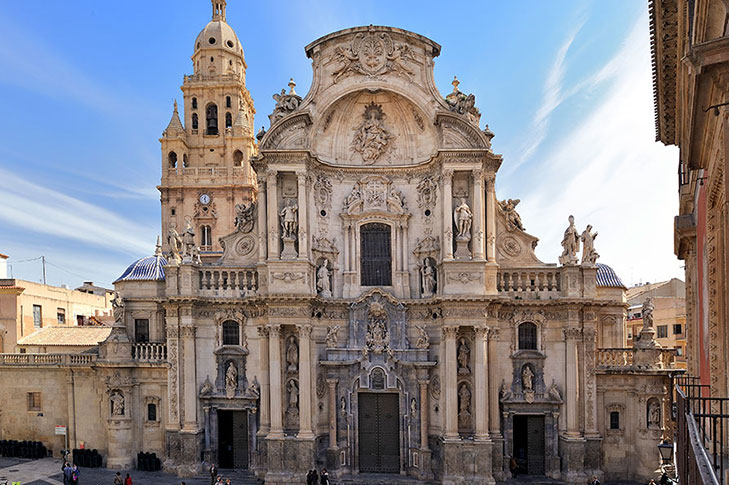
Removed from Unnamed collection
Museum of the Cathedral of Murcia 
The most important temple in the Region is a magnificent merge of styles, a catalogue of stone which summarizes more than six centuries of art and history.
Its construction began in 1394 over the remains of an old Arabic mosque and in 1462 its vaults were finished. The oldest entrance is La Puerta de Los Apóstoles (the door of the Apostles). Its only storefront is flanked by pointed archivolts with statues of the apostles on it. La Puerta de las Cadenas( the door of the Chains) dates from 1513 and has original pilasters and archivolts.
From the 15th century dates the Capilla de Los Vélez covered by a ten-pointed star vault and profusely decorated. Another famous chapel is that of Junterón, whose oval ground plan is covered by an extremely original vault.
Its baroque main façade (Imafronte), Jaime Bort¿s work, is an exaltation of Levantine art (the 18th century eastern Spain art). It is divided as an altarpiece into two parts and three vertical sections. The tower, divided into five parts, is 92 meters high. Its construction started in 1511 and the fifth body hosts twenty-five church bells https://www.murciaturistica.es/en/monument/catedral-de-murcia-327/
Map
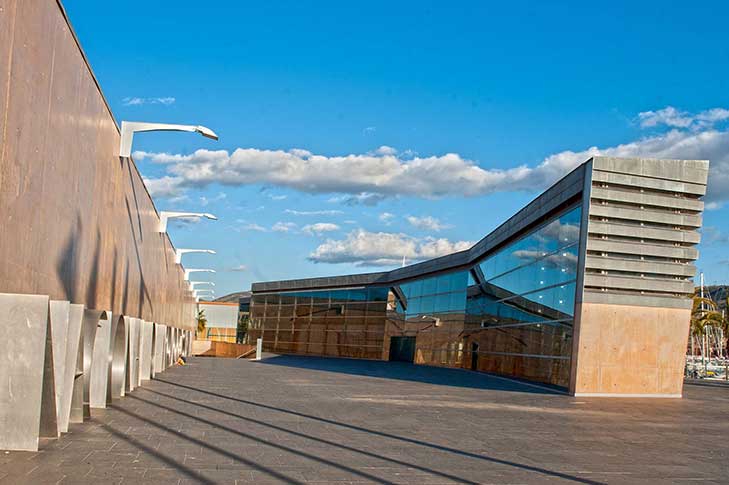
Removed from Unnamed collection
National Museum of Underwater Archaeology 
ARQUA Museo Nacional de Arqueología Subacuática is the institution in charge of studying, valuing, investigating, preserving, disseminating and protecting the Spanish underwater cultural heritage. It is also home to the Permanent Observatory for the National Plan for the Protection of Underwater Cultural Heritage.
These tasks are carried out in collaboration with the different regional governments and its research centres and in cooperation with the States who partner with the UNESCO Convention.
Furthermore, the ARQUA has recently taken charge of the Odyssey’s treasure. The Nuestra Señora de las Mercedes frigate collection, which consists of more than 570,000 gold and silver coins from the late 18th century and the beginning of the 19th century. https://www.murciaturistica.es/en/museum/arqua-museo-nacional-de-arqueologia-subacuatica-132/
Map
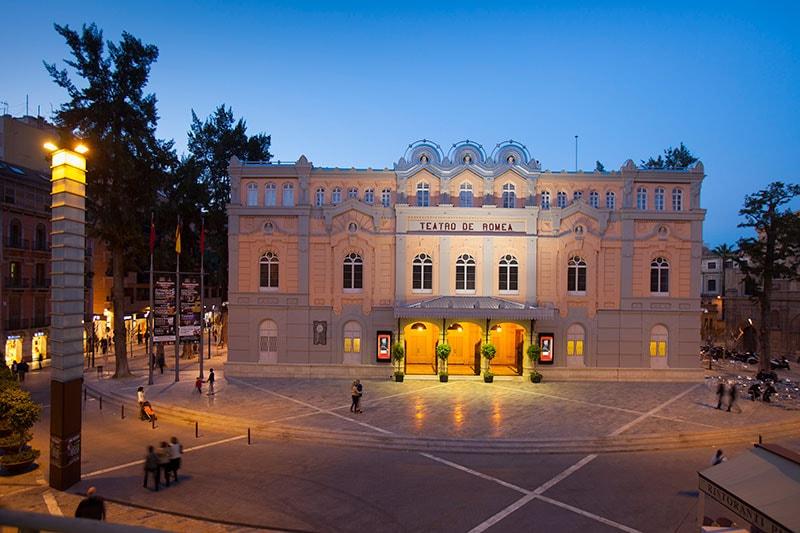
Removed from Unnamed collection
Romea Theater 
With more than 150 years of history, the eclectic building of the Romea Theater is one of the most important cultural references of the city. Built after an earlier one that suffered two fires, the current theater was inaugurated in 1900 thanks to the architect Justo Millán. https://www.murciaturistica.es/en/monument/teatro-romea-955/
Map
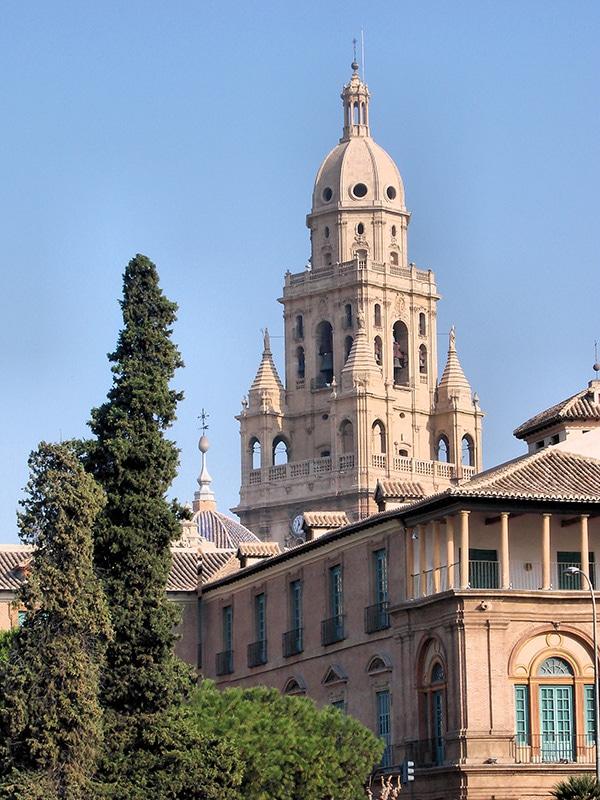
Removed from Unnamed collection
The Episcopal Palace 
This one was demolished to give a much cleaner view to the facade of the Cathedral. Currently the Episcopal Palace occupies a place close to what used to be the Palacio del Alcázar. https://www.murciaturistica.es/en/monument?ficha=329
Map

Removed from Unnamed collection
La Seu (Majorca Cathedral)
The Cathedral is Majorca's most emblematic monument, as it perfectly synthesises the last eight centuries of its history. The image of a great ship on the sea dominating the bay of Palma with its beauty and presence first surprises visitors before arousing their curiosity and becoming a symbol of the island's historical and spiritual heritage.
Built next to the Mediterranean, the Cathedral leads a monumental ensemble, evoking the cultures that came before the conquest of Madina Mayurqa, on 31 December 1229, by James I, the King of Aragon and Count of Barcelona. James the Conqueror, following the habit of the time, consecrated the old mosque to the Virgin Mary and prepared to build a new church in the style of the era. There is documentary evidence from 1230 relating to the work on the Cathedral. http://www.visitpalma.com/en/contenido/lugares-de-interes/lugarinteres/La-Seu-Majorca-Cathedral/
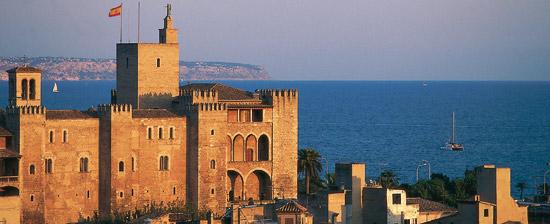
Removed from Unnamed collection
La Almudaina Royal Palace
La Almudaina Palace was the seat of the independent kingdom of Majorca during the reigns of Jaime I, Sancho I and Jaime II, until it became part of the kingdom of Aragon under Pedro IV. The castle visible today is the result of modifications to the Muslim fortress constructed from 1281. http://www.spain.info/en_IN/que-quieres/arte/monumentos/mallorca/palacio_real_de_la_almudaina.html
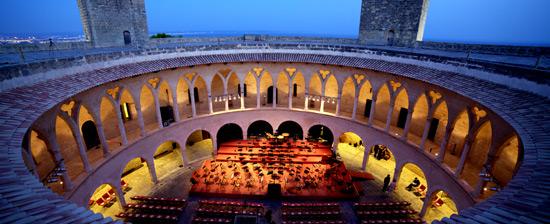
Removed from Unnamed collection
Bellver Castle
The castle is located on the crest of a hill and is in the Gothic style. Bellver Castle has had various different uses over the course of its history. King Jaime II ordered its construction as a royal residence. In the 19th century it was converted into a mint. http://www.spain.info/en_IN/que-quieres/arte/monumentos/mallorca/castillo_de_bellver.html

Removed from Unnamed collection
Historic Center of Arona 
The very heart of the town (declared an Asset of Cultural Interest) is represented by the church of San Antonio Abad, from the 18th century, located right in the space that a hermitage occupied a hundred years ago. Inside the temple, the image of the Christ of Health is its most valuable piece. Around, the stately homes and cobbled streets invite a peaceful walk. https://www.webtenerife.com/que-visitar/lugares-historicos/centros-historicos/centro+historico+de+arona.htm
Map

Removed from Unnamed collection
Alcazar of Jerez de la Frontera 
The Alcázar de Jerez one of the most emblematic monuments of the city. Located in the southeast corner of the walled enclosure, forming a complex defensive system with the walls, towers and gates.
The term alcazar, comes from Arabic, al-qasr and defines a set of buildings, surrounded by walls, which were the seat of political and military power. Fortress-palace with autonomous operation, a small city, seat of power that governed the city and its territory.
From the original Islamic fortress, the two doors are preserved; the mosque, the Arab baths; the octagonal tower and the Pavilion of the Doña Blanca patio, located at the foot of this tower. http://www.turismojerez.com/index.php/en/what-to-visit-in-jerez/culture-3/museums-and-heritage-centres/item/334-conjunto-monumental-del-alc%C3%A1zar-y-camara-oscura/334-conjunto-monumental-del-alc%C3%A1zar-y-camara-oscura
Map

Removed from Unnamed collection
Jerez de la Frontera Cathedral 
The long period of time over which it was built caused a variety of styles to be integrated into the structure of this cathedral.
It was built as a Collegiate Church, since Jerez did not have a bishopric until 1980. Building began in 1695 and lasted until 1778. Participating architects included Diego Moreno Meléndez, Rodrigo del Pozo, Diego Díaz, Juan de Pina, Torcuato Cayón de la Vega, Juan de Vargas and Pedro Ángel de Albizu. The building has a rectangular plan, with five naves. It is Baroque in style. http://www.spainisculture.com/en/monumentos/cadiz/catedral_de_jerez_de_la_frontera.html
Map

Removed from Unnamed collection
The Cloisters of Santo Domingo 
In 1264 the troops of Alfonso X conquer Jerez definitively to the Muslims. At that time, the monarch gave the Dominicans a military building of Islamic origin located in front of the door of Seville, to found their convent there. The first century of existence of the monastery of Santo Domingo had to be very hard, since the attacks by the Nasrid Kingdom of Granada and its North African allies were constant.
The convent of Santo Domingo remained a united group until 1835, when the different confiscations of the liberal governments of Isabel's reign decreed the exclaustration and seizure of the assets of the convent. Although the church remained open to worship, the cloisters were sold. In the beginning, the owners were Los González, an important family of winemakers from Santander Mountain, who installed here the so-called Museum of Santo Domingo, a kind of trinket in which works of art, furniture and other decorative objects were sold. Then the complex became the property of the Díez family, who installed a cellar in the old bedroom and made a series of somewhat aggressive works with the monument. Los Dietros sold Los Claustros to the Rumasa holding company, which was expropriated in 1983, becoming the property of the City Council, which used it as cultural equipment for years. In 1999 the complex was closed for restoration, reopening its doors in 2012. http://www.turismojerez.com/index.php/en/what-to-visit-in-jerez/culture-3/jerez-monumental-secular-monuments/item/1455-los-claustros-de-santo-domingo?catid=102
Map
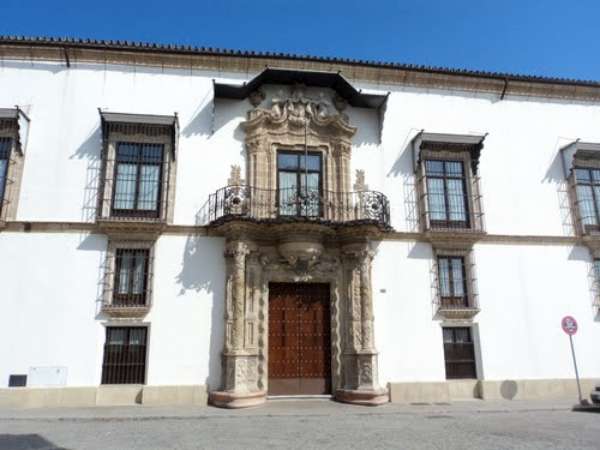
Removed from Unnamed collection
Bertemati Palace 
Bertemati Palace is located at
Plaza del Arroyo 50 and 51. http://www.turismojerez.com/index.php/en/what-to-visit-in-jerez/culture-3/jerez-monumental-buildings/item/1480-palacio-bertemati?catid=101
Map
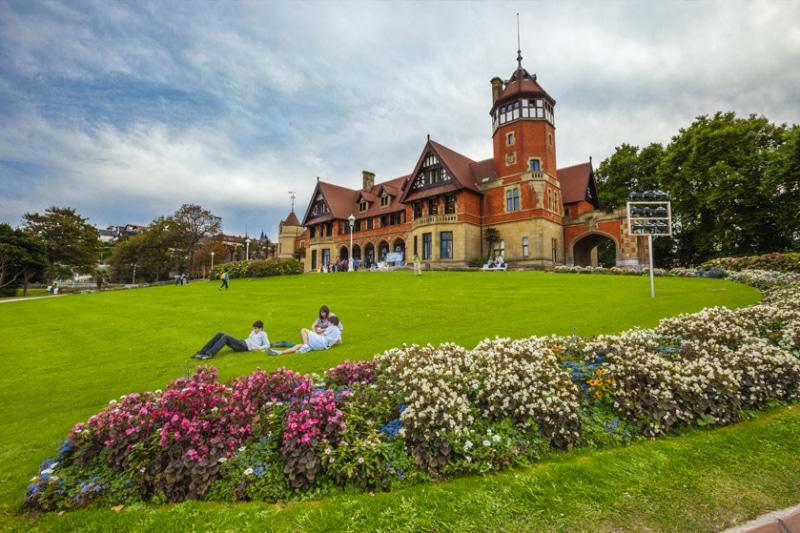
Removed from Unnamed collection
Miramar Palace 
Miramar Palace was built in 1893 on the order of Queen María Cristina of Austria, who used to spend her summers in Donostia/San Sebastián. After considering other places such as Monte Urgull and Aiete, the queen settled on this location, where there had previously been a hermitage which had to be moved to another spot. Nowadays, if you visit the Antiguo neighbourhood you will find the palace among its streets.
In first impressions, the palace is reminiscent of English noble country houses. Designed by the English architect Selden Womun and built by the master craftsman José Goikoa, for years it remained in the hands of the Spanish Royal Family, serving as their summer residence and as the college of Juan Carlos de Borbón. https://www.sansebastianturismoa.eus/en/to-do/culture-art-architecture/mansions-and-castles/miramar-palace
Map

Removed from Unnamed collection
San Sebastian Old Town 
Tradition and modernity are brought together in one of the most special areas of the city. Stroll through the fishing port and lose yourself in the streets of the Historical Quarter where the smell of pintxos emanates from every corner. Cross the Boulevard and leap through time to land in the centre of Donostia, and visit its pedestrian streets and spend a few hours shopping in its lovely shops and boutiques. https://www.sansebastianturismo.com/en/to-do/district-by-district/centre-old-town
Map
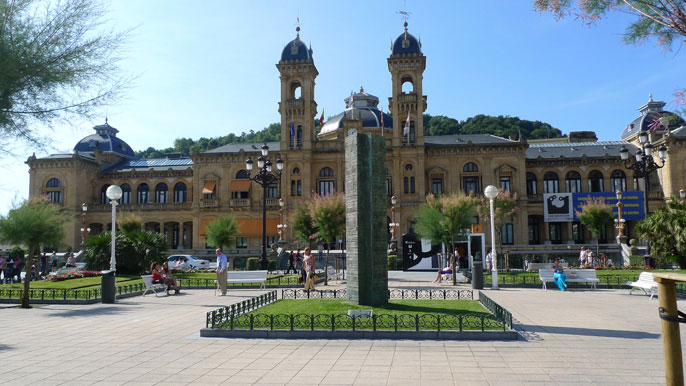
Removed from Unnamed collection
San Sebastian's City Hall 
What is today San Sebastián's City Hall was home to the city’s Gran Casino from the time it was opened on 1st July 1897 until it was closed in 1924 with the prohibition of gambling. Its roulette tables and Dance Hall, currently the Plenary Hall, provided entertainment for politicians, writers and artists in the Belle Epoque period. https://www.sansebastianturismo.com/en/to-do/culture-art-architecture/belle-epoque#ayuntamiento
Map
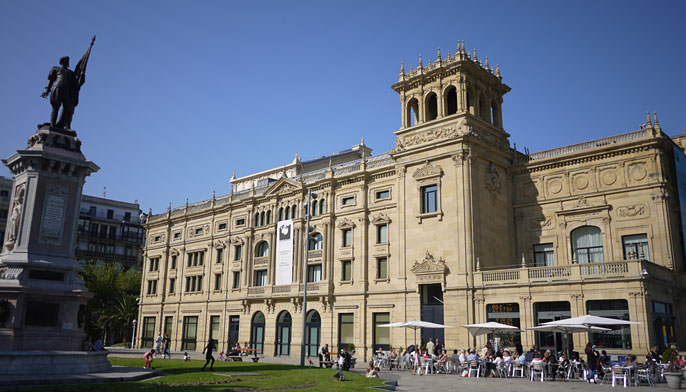
Removed from Unnamed collection
Victoria Eugenia Theater 
Belle Epoque in design yet highly modern in spirit. That’s how we could describe the Victoria Eugenia Theatre, a building that celebrated its 100th anniversary in 2012. Located in the city centre, in full view of the Kursaal and on the banks of the River Urumea, the Victoria Eugenia Theatre proposes a varied and continually changing programme.
This sandstone building sporting plateresque motifs with Spanish Renaissance forms was created by the architect Francisco de Urcola in 1912. Particularly interesting on the facade are, over the Doric columns, four groups of sculptures representing the opera, tragedy, comedy and drama.
For decades the Victoria Eugenia Theatre has been the principal hub of the International Film Festival; since its renovation in 2007, the building now offers new cutting edge spaces and audiovisual technologies. https://www.sansebastianturismo.com/en/to-do/culture-art-architecture/belle-epoque#ayuntamiento
Map

